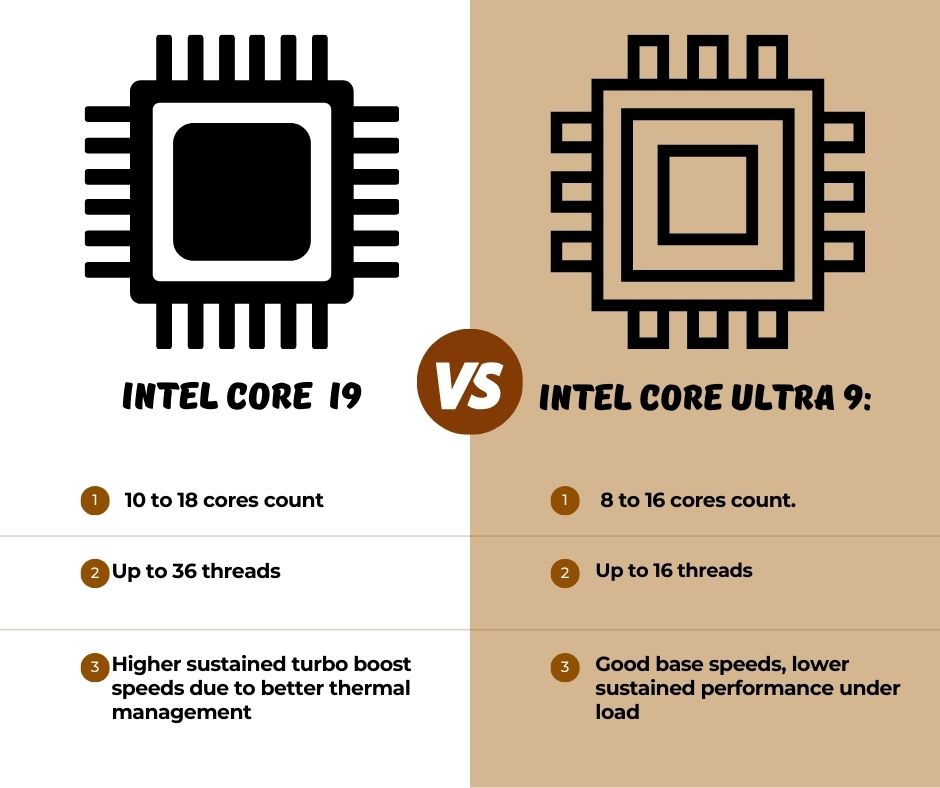When it comes to choosing a processor, the options can be overwhelming. Intel has long been a leader in the CPU market, and its latest offerings, intel Core Ultra 9 and Core i9 are no exception. But how do you determine which one is better for your needs? In this blog, we’ll explore the key differences between these two powerful processors, helping you make an informed decision.

Understanding the Basics Intel Core Ultra 9
First, let’s clarify what each processor is designed for. The Intel Core Ultra 9 is part of Intel’s latest lineup, focusing on efficiency and integrated AI capabilities. It aims to deliver strong performance in thin and light laptops. On the other hand, the Core i9 is a powerhouse designed for gamers and professionals who require maximum processing power.
Core Count and Threads Intel Core Ultra 9
One of the most significant differences lies in core count and threading capabilities. The Core i9 generally features more cores than the Ultra 9.
- Core i9: Typically has 10 to 18 cores.
- Core Ultra 9: Usually has around 8 to 16 cores.
More cores mean better multitasking. If you’re running multiple applications at once or engaging in heavy tasks like video editing or gaming, the i9 shines here. It can handle more threads simultaneously, making it ideal for demanding workloads.
Clock Speed Intel Core Ultra 9
Next up is clock speed. This metric indicates how fast a processor can execute tasks.
- Base Clock Speed: Both processors have similar base clock speeds.
- Turbo Boost: The Core i9 can sustain higher turbo boost speeds longer due to better thermal management.
This means that during intense workloads, the i9 will likely perform better. If you’re gaming or using software that requires quick processing, this can make a noticeable difference.
Performance Benchmarks Intel Core Ultra 9
Benchmarks provide valuable insights into how well each processor performs under various conditions.
- Single-threaded Performance: In many cases, the Core i7 performs comparably to the i9 in single-threaded tasks.
- Multi-threaded Performance: Here’s where the i9 really stands out. It often outperforms the Ultra 9 significantly due to its higher core count.
If your work involves software that utilizes multiple threads—like video editing software or complex simulations—the i9 will likely give you better results.
Cache Size Intel Core Ultra 9
It is another important factor to consider. Its memory stores frequently accessed data for quick retrieval.
- Core i9: Features larger L2/L3 cache sizes (up to 25 MB).
- Core Ultra 9: Generally has smaller cache sizes (up to 16 MB).
A larger cache helps with faster data access, which can improve overall performance in data-heavy applications. If you work with large files or databases.
Power Consumption and Thermal Management
Power consumption is crucial when choosing a processor.
- Core i9: Consumes more power due to its higher core count and performance capabilities.
- Core Ultra 9: More energy-efficient, making it suitable for portable devices.
This difference means that if you choose an i9, you may need a more robust cooling solution and a power supply that can handle its demands. For casual users or gamers who don’t push their systems hard, the Ultra 9 might be the better choice.
Price Consideration
Let’s talk about cost. The Core i9 is generally more expensive than the Core Ultra 9, and this price difference can be substantial.If you’re on a budget or need a processor for gaming and everyday tasks, the Core Ultra 9 offers excellent value without sacrificing too much performance. However, if you’re a professional requiring top-tier performance for tasks like video editing or 3D rendering, investing in an i9 could improve efficiency and speed.
Use Cases: Which One Is Right for You?
Now that we’ve covered the technical aspects, let’s discuss practical use cases.
Choose Core i9 If:
- You are a content creator working with high-resolution video.
- It runs virtual machines or does heavy multitasking.
- You want to future-proof your system for demanding applications.
- You play games at ultra settings and want maximum performance.
Choose Core Ultra 9 If:
- You primarily play games but also create some light content.
- Your tasks are not heavily multi-threaded.
- You’re looking for a balance between performance and cost.
- You want an efficient system without needing high-end cooling solutions.
Real-world Performance: User Experiences
User experiences can provide additional insights into how these processors perform in everyday scenarios. Many gamers report that both processors deliver excellent gaming experiences.
However, those using the latest titles at ultra settings often prefer the extra power of the Core i9.
Content creators frequently note that rendering times decrease significantly with an i9 compared to an Ultra 9. This time saved can be crucial for professionals working on tight deadlines.
Future-Proofing Your System
Another consideration is future-proofing your system. Technology evolves rapidly, and software demands increase over time. Investing in an Intel Core i9 may provide longevity as applications become more resource-intensive.
If you plan to keep your system for several years without upgrading components frequently, opting for an i9 could be wise. It will likely handle future software demands better than an Ultra 9 over time.
Integrated Graphics
Another aspect worth mentioning is integrated graphics performance. The Core Ultra 9 often comes with improved integrated graphics capabilities thanks to Intel’s advancements in this area.
If you’re not planning on using a dedicated GPU or if you’re building a lightweight laptop where space is limited, this feature could be beneficial. The integrated graphics on the Ultra 9 may allow for decent gaming performance at lower settings without needing an additional graphics card.
On the other hand, while some versions of the Core i9 have integrated graphics as well, they are generally aimed at users who will pair them with high-performance dedicated GPUs for optimal gaming or professional work scenarios.
Cooling Solutions
Cooling solutions are essential when considering these processors as well. The Core i9 generates more heat due to its higher performance capabilities and core count.
Therefore, it often requires advanced cooling solutions like liquid cooling systems or high-end air coolers to maintain optimal temperatures during intensive tasks.
In contrast, the Core Ultra 9’s lower power consumption means it runs cooler overall, making it easier to manage heat in compact builds or laptops without needing extensive cooling solutions.
Compatibility with Motherboards
Compatibility with motherboards is another factor worth considering when choosing between these two processors. The Core i9 typically requires more robust motherboards that support higher power delivery and advanced features like overclocking capabilities.
The Ultra 9 may work well with standard motherboards designed for mid-range builds, making it easier to find compatible components if you’re building a budget-friendly system.
Conclusion: Making Your Decision
In conclusion, determining whether the Intel Core Ultra 9 is better than the Core i9 depends largely on your specific needs and budget.
If you require top-tier performance for demanding tasks and are willing to invest more money into your system, go for the Core i9. However, if you’re looking for great performance at a more accessible price point—especially for gaming and everyday tasks—the Core Ultra 9 remains an excellent choice.
Ultimately, both processors have their strengths and weaknesses. By understanding these differences and considering your requirements, you can make an informed decision that best suits your needs.
Whether you choose the Intel Core Ultra 9 or the Core i9, both options promise impressive performance tailored to different user needs—so choose wisely! Happy computing!
